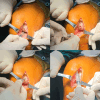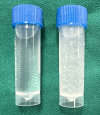Magnesium sulphate and sodium bicarbonate as additives for periarticular local infiltration analgesia improve pain management after unicompartmental knee arthroplasty: a prospective, double-blind, randomized controlled trial
- PMID: 39558412
- PMCID: PMC11571767
- DOI: 10.1186/s13018-024-05233-6
Magnesium sulphate and sodium bicarbonate as additives for periarticular local infiltration analgesia improve pain management after unicompartmental knee arthroplasty: a prospective, double-blind, randomized controlled trial
Abstract
Background: Periarticular local infiltration analgesia (LIA) has become a widely used method for postoperative pain management after unicompartmental knee arthroplasty (UKA). However, the efficacy of using magnesium sulphate or sodium bicarbonate in LIA cocktails during UKA is not yet clear. The present study aimed to evaluate whether the modified LIA has advantages in pain control and joint function recovery after UKA surgery.
Methods: Sixty-one patients who underwent UKA were enrolled and randomly assigned to receive periarticular infiltration of a modified cocktail (comprising ropivacaine, epinephrine, dexamethasone, magnesium sulphate, and sodium bicarbonate) or a conventional cocktail (comprising ropivacaine, epinephrine, dexamethasone, ketorolac, and morphine). The outcomes included the consumption of patient-controlled intravenous analgesia (PCIA) medication used for postoperative analgesia, pain score, early joint functional recovery, discharge time, and complication rates.
Results: In the first 12 h after surgery, the conventional cocktail was not superior to the modified cocktail in terms of visual analogue scale (VAS) scores. However, beginning on the second postoperative day, the analgesic effect was significantly prolonged in the modified group, leading to lower VAS scores and better knee functional recovery. Additionally, patients in the modified group required less pain medication via PCIA, both within the first 24 h and cumulatively up to 48 h after surgery. Both groups had similar rates of complications.
Conclusions: The present modification of a conventional cocktail significantly prolonged the analgesic effect and reduced pain medication consumption after UKA surgery, which was associated with better functional recovery in the early postoperative days.
Trial registration: Chinese Clinical Trial Registry, ChiCTR2200060500. 21 March 2023.
Keywords: Analgesic drugs; Cocktail; Magnesium sulphate; Periarticular local infiltration analgesia; Sodium bicarbonate; Unicompartmental knee arthroplasty.
© 2024. The Author(s).
Conflict of interest statement
Figures




Similar articles
-
Effects of magnesium sulfate on periarticular infiltration analgesia in total knee arthroplasty: a prospective, double-blind, randomized controlled trial.J Orthop Surg Res. 2023 Apr 14;18(1):301. doi: 10.1186/s13018-023-03790-w. J Orthop Surg Res. 2023. PMID: 37060089 Free PMC article. Clinical Trial.
-
Efficacy of a Modified Cocktail for Periarticular Local Infiltration Analgesia in Total Knee Arthroplasty: A Prospective, Double-Blinded, Randomized Controlled Trial.J Bone Joint Surg Am. 2023 Mar 1;105(5):354-362. doi: 10.2106/JBJS.22.00614. Epub 2023 Mar 1. J Bone Joint Surg Am. 2023. PMID: 36856693 Clinical Trial.
-
Effects of a Modified Long-Acting Cocktail on Analgesia and Enhanced Recovery After Total Hip Arthroplasty: A Double-Blinded Randomized Clinical Trial.J Arthroplasty. 2024 Oct;39(10):2529-2535. doi: 10.1016/j.arth.2024.05.019. Epub 2024 May 10. J Arthroplasty. 2024. PMID: 38735542 Clinical Trial.
-
Adding corticosteroids to periarticular infiltration analgesia improves the short-term analgesic effects after total knee arthroplasty: a prospective, double-blind, randomized controlled trial.Knee Surg Sports Traumatol Arthrosc. 2021 Mar;29(3):867-875. doi: 10.1007/s00167-020-06039-9. Epub 2020 May 2. Knee Surg Sports Traumatol Arthrosc. 2021. PMID: 32361928 Clinical Trial.
-
Comparison of Periarticular Local Infiltration Analgesia With Femoral Nerve Block for Total Knee Arthroplasty: a Meta-Analysis of Randomized Controlled Trials.J Arthroplasty. 2018 Jun;33(6):1972-1978.e4. doi: 10.1016/j.arth.2017.12.042. Epub 2018 Jan 11. J Arthroplasty. 2018. PMID: 29455938 Review.
References
-
- Hurst JM, Ranieri R, Berend KR, Morris MJ, Adams JB, Lombardi AV. Jr. Outcomes after arthroscopic evaluation of patients with painful medial unicompartmental knee arthroplasty [J]. J Arthroplasty. 2018;33(10):3268–72. - PubMed
-
- Bianconi M, Ferraro L, Traina GC, Zanoli G, Massari L. Pharmacokinetics and efficacy of ropivacaine continuous wound instillation after joint replacement surgery [J]. BJA Br J Anaesth. 2004;91(6):830–5. - PubMed
-
- Wang Q, Tan G, Mohammed A, Zhang Y, Li D, Chen L, Kang P. Adding corticosteroids to periarticular infiltration analgesia improves the short-term analgesic effects after total knee arthroplasty: a prospective, double-blind, randomized controlled trial [J]. Knee Surg Sports Traumatol Arthrosc. 2021;29(3):867–75. - PubMed
Publication types
MeSH terms
Substances
Grants and funding
LinkOut - more resources
Full Text Sources
Medical

